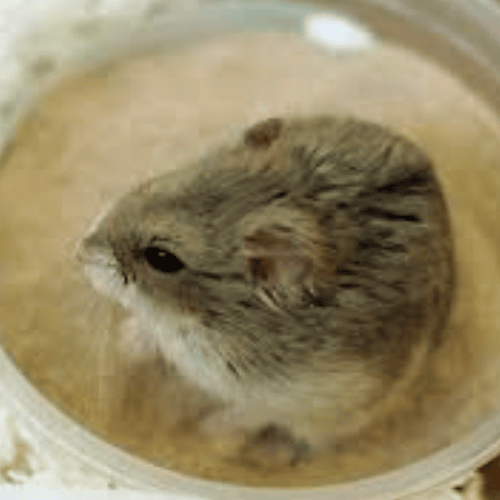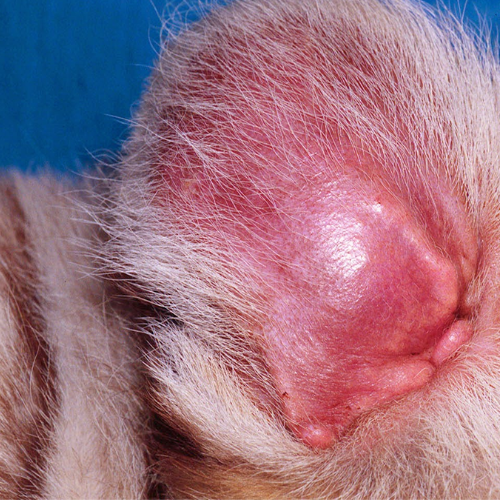Many hamsters die from tumors/cancers; however, this isn’t generally the cause. The average lifespan of these hamsters is only a few short months, which is unfortunate. If you’ve seen significant lumps on your hamster’s balls/testicles, please pay close attention to the following guidelines.
In male hamsters, the development of lumpy testicles can be attributed to the presence of testicular cancer caused by abnormally rapid cell proliferation in the testicles. The firm lumps exhibit enlargement due to internal pressure and may not even retract normally in cold conditions. People who have never seen a hamster before are shocked to find that the testicles are disproportionately large compared to the rest of the animal’s body.

The discovery of testicular tumors frequently induces a fearful state in the owners of hamsters. Not all extra growths are tumors; occasionally, they’re only a nuisance with no major health consequences.
What Is Male Testicular Cancer in Hamsters?
Cancer of the testicles begins in the male gland, commonly referred to as a testicle or testis. The testicles of a male hamster will develop as the animal grows. An adult hamster’s testicles protrude when heated and retract when chilly. On the other hand, male Chinese dwarf hamsters often maintain a noticeable appearance of their testicles throughout their whole lives.
There is no need to panic if these lumps form. If a hamster’s testicles grow rigid, enlarged, or do not finally retract, there is cause for concern. These are some of the symptoms that may point to a testicular tumor. Consult a veterinarian to receive a diagnosis. Surgery and castration may be the best treatments.
Why is my Hamster Aggressive & What Can I do About it?
Is It Possible for Hamsters to Get Tumors?
There is some evidence that hamsters can have tumors. The outcome is identical whether they are named lumps or tumors—a growth of extra cells that doesn’t serve any specific function and could be fatal.
At any age, it may develop itself, and it has the potential to affect any portion of the hamster’s body. Older hamsters have a higher tumor risk than younger ones.
The majority of cases of tumors are susceptible to treatment, particularly when detected at an early stage. It also relies on the tumor’s location. For instance, a growth on the exterior of a leg is simple to remove, but one in the testicle of a hamster is difficult.
Possible Causes of Hamster Tumors
Hamsters are susceptible to developing tumors in a manner that is very similar to that of humans. Why hamsters get tumors is exactly as mysterious as why people do.
In most cases, the hamster’s cells have been programmed. Their programming occasionally goes incorrect, but they renew every several days. Therefore, old cells can forget to die, yet new cells will continue to emerge. Because of this, there is excessive growth, which is not relatively healthy. As a result, the lump might be caused by several different events.
To begin with, you should be aware that a tumor is an aberrant cellular proliferation with no obvious purpose. There are primarily two different kinds:
- A benign tumor is just an excessive development of the cells, but it does not spread to other body areas.
- A malignant tumor may spread to other areas on or inside the body.
Hamster Testicular Tumor Signs
If you think your hamster has testicular tumors, see a vet. On the other hand, the following symptoms, which are only seen in male hamsters, are frequently related to the illness.
Swollen Testicles
The most noticeable symptom of testicular tumors in hamsters is the development of enlarged and irregularly shaped balls. Male hamsters are easily distinguished from other rodents by their relatively large testicles. On the other hand, the sight of lumps might cause them to grow considerably larger overnight.
The size of a lump may gradually increase over time, despite its normally modest beginnings. The lumps can quadruple the testicles’ size, making them noticeable at a look. The only way to determine if a node is benign or cancerous is to consult a veterinarian for an accurate study and diagnosis.
The existence of lumps makes a male’s testicles harder than usual; you may tell by feeling them. Lifting him to check for lumps or tumors shouldn’t be an issue if you have a good relationship with your hamster.
Why is my Hamster Breathing Fast?
Discolored Testes
The colour of a hamster’s enormous testicles, which are normally reddish, might vary. When a tumor begins to grow inside, it not only causes the testicles to appear larger than they were before, but it also causes them to change color. The damaged testicle may be darker than the healthy one.
Even if the lumps are small, the discoloration of the testicles should be a warning sign that your hamster requires to see a vet immediately.
Loss of Appetite
Hamsters consume food throughout the night when they are typically up and active. When hungry, they may wake up from naps to eat. On the other hand, the discomfort caused by disorders such as testicular cancer can substantially impact patients’ appetites.
If your hamster cannot eat or drink, perform a physical inspection before seeing the clinic. There is a chance that you will find significant cell growth in the testicles.
Reduced Activity
You know hamsters need continual physical exercise from dark to morning if you’ve raised them. One of their favourite things is to run on the exercise wheels, but they also like exploring the tunnels and hideouts in their enclosures and racing around in their cages.
As soon as you see a decrease in the hamster’s level of physical activity, you should immediately do a thorough physical check of the animal’s testicles in search of indications of abnormalities. The balls may have been experiencing an outbreak of malignant cells.
Abnormal Walking
Changes in the hamster’s walk might indicate trouble underneath. The little guy’s walk may be affected by the pain caused by the testicular tumor, in addition to the inflammation caused by his already enormous balls.
Since their bigger testicles function as a barrier, it is fairly uncommon for male hamsters to exhibit a slight butt lifting behavior when moving around.
Testicular Tumor Treatment for Hamsters
After receiving the sad news that your hamster has testicular cancer, it is time to start looking for treatment options. There are only two treatment methods that are now considered to be effective for treating testicular tumors.
Feed Hamsters Dandelions
The use of green leafy vegetables like dandelion greens is suggested for hamsters that are suffering from testicular cancer. It offers potent vitamins such as A and C, which strengthen the immune system of the pet rodent, making it better able to ward off illnesses.
Dandelions are an essential plant for hamsters because they offer natural diuretic qualities that prevent fluid accumulation in tumors. The collected pus around the damaged balls can worsen the swelling and increase the affected hamster’s pain level.
Castration or Surgery on the Testicles
Surgery on the testicles is the most successful treatment for tumors found in male hamster balls. This procedure, also known as castration, involves removing one or more testicles from the young male to have a healthy and productive life.
The procedure is usually done by an exotics surgeon in a clinic using a local anesthetic. Surgery can potentially stop the spread of cancer to other essential organs, which would otherwise end in death.

Doctor of Veterinary Medicine (D.V.M.) at Nation Taiwan University,Master of Science (M.S.) in Biomedical Engineering at National Taiwan University of Science and Technology




